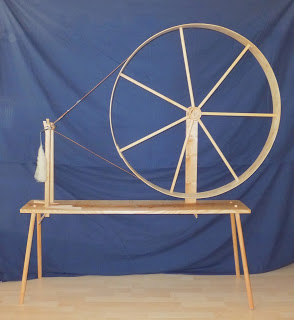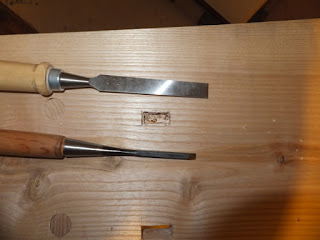Now that you know my thoughts on what is important on a spindle wheel for spinning, you might want to check out what other people think, or get some more information about these wheels, and a few other perspectives on them
As usual, there's some stuff to be found on the Internets. One very nice article with pictures of different kinds of spindle bearings on Great Wheels is the one Lee Juvan wrote for Knitty. She also lists some literature in that piece, including literature for tips on how to spin with this drafting style. Another collection of spindle wheel heads can be found here, including a nice example of a Minor's Head. Another several examples are in the collection of Old Sturbridge Village Museum.
If you want to buy an antique (or even a modern) Great Wheel for your spinning, I'd strongly recommend to take a look at the wheel and try before you buy. This, obviously, might not be possible in all cases - the wheel might need some tender loving care, or work being done, before it will spin, or it might be too far away for you to travel before buying. In this case, you'll have to depend on the seller's description plus photographs and your own judgement - and in the end, hope that you are lucky and get what you are looking for. Blind-buying spinning wheels of any kind is not something I'd recommend, but if you have to, don't hesitate to ask for detail pictures of crucial bits, or specific questions about the wheel and its parts.
If you are looking into building one of these beasts yourself, there's one whole issue about Great Wheels in the Spinning Wheel Sleuth, a newsletter just about spinning wheels - it's the October 2014 issue. You can also check out the articles on this blog tagged "building a Whool Wheel", and feel free to ask questions in the comments - I'll try to be as helpful as possible.
Whether you are planning to do the building yourself or have a woodworker/spinning wheel maker do it for you, previous experience with ordering tools from craftspeople has taught me this: Make sure the person building the thing really, really understands what are the important bits, how the thing works, and how it is going to be used. If you have not spun on a Great Wheel before, I'd advise you to try and get that experience before you get one yourself, whatever way you will use to get it. Having a personal experience and understanding how the process works will help you explain to your crafter what to watch out for.
When planning out the wheel, make sure you pay attention to where the wheel hub will be, height-wise, compared to you as the spinner - you want it at a place where you can comfortably keep the wheel in motion without bending down or stretching up. Make sure the bench construction carrying the wheel is sturdy enough to support the wheel without wobbling. Alignment of the wheel and spindle, as well as appropriate weight for the wheel (as light as possible would be my advice) are the other key points.
Make a list beforehand of the things that are important for you. Make drawings. Then make sure the important things are all duly understood, and incorporated into the design. Communication with crafters can be difficult if they have no understanding on how this wheel works, and chances are high that your normal woodworker, or even your normal modern-ish flyer spinning wheel maker, will not know how Great Wheels tick, and what to look out for. So be prepared - maybe even bring a video showing how spinning is done on such a wheel.
Happy hunting, building or commissioning your wheel!
As usual, there's some stuff to be found on the Internets. One very nice article with pictures of different kinds of spindle bearings on Great Wheels is the one Lee Juvan wrote for Knitty. She also lists some literature in that piece, including literature for tips on how to spin with this drafting style. Another collection of spindle wheel heads can be found here, including a nice example of a Minor's Head. Another several examples are in the collection of Old Sturbridge Village Museum.
If you want to buy an antique (or even a modern) Great Wheel for your spinning, I'd strongly recommend to take a look at the wheel and try before you buy. This, obviously, might not be possible in all cases - the wheel might need some tender loving care, or work being done, before it will spin, or it might be too far away for you to travel before buying. In this case, you'll have to depend on the seller's description plus photographs and your own judgement - and in the end, hope that you are lucky and get what you are looking for. Blind-buying spinning wheels of any kind is not something I'd recommend, but if you have to, don't hesitate to ask for detail pictures of crucial bits, or specific questions about the wheel and its parts.
If you are looking into building one of these beasts yourself, there's one whole issue about Great Wheels in the Spinning Wheel Sleuth, a newsletter just about spinning wheels - it's the October 2014 issue. You can also check out the articles on this blog tagged "building a Whool Wheel", and feel free to ask questions in the comments - I'll try to be as helpful as possible.
Whether you are planning to do the building yourself or have a woodworker/spinning wheel maker do it for you, previous experience with ordering tools from craftspeople has taught me this: Make sure the person building the thing really, really understands what are the important bits, how the thing works, and how it is going to be used. If you have not spun on a Great Wheel before, I'd advise you to try and get that experience before you get one yourself, whatever way you will use to get it. Having a personal experience and understanding how the process works will help you explain to your crafter what to watch out for.
When planning out the wheel, make sure you pay attention to where the wheel hub will be, height-wise, compared to you as the spinner - you want it at a place where you can comfortably keep the wheel in motion without bending down or stretching up. Make sure the bench construction carrying the wheel is sturdy enough to support the wheel without wobbling. Alignment of the wheel and spindle, as well as appropriate weight for the wheel (as light as possible would be my advice) are the other key points.
Make a list beforehand of the things that are important for you. Make drawings. Then make sure the important things are all duly understood, and incorporated into the design. Communication with crafters can be difficult if they have no understanding on how this wheel works, and chances are high that your normal woodworker, or even your normal modern-ish flyer spinning wheel maker, will not know how Great Wheels tick, and what to look out for. So be prepared - maybe even bring a video showing how spinning is done on such a wheel.
Happy hunting, building or commissioning your wheel!












